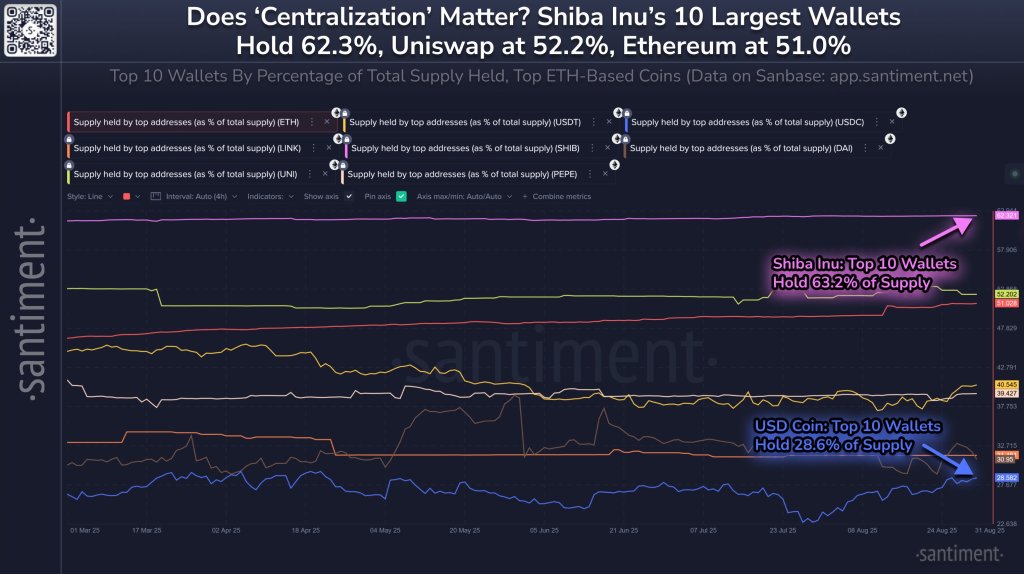Upon perusing the latest musings shared on X by the ever-so-diligent analysts at Santiment, one cannot help but marvel at the peculiar state of affairs within the Ethereum ecosystem. It seems that a select few have taken it upon themselves to hoard the majority of its riches, leaving the rest of us mere mortals to squabble over the crumbs.
Ah, but let us turn our attention to the chart they so graciously provided in their post, which depicts the concentration of wealth among eight cryptocurrencies in recent months. Behold, if you will, the visual representation of inequality:

According to these revelations, a staggering 51% of Ethereum’s supply resides within the coffers of just ten wallets. One might call it a modern-day aristocracy, though I daresay even the landed gentry of old would blush at such audacity.
Yet, lo and behold, there are two tokens that outdo Ethereum in this display of financial elitism: Shiba Inu (SHIB) and Uniswap (UNI). UNI sits modestly above ETH with 52.2%, while SHIB, that cheeky upstart, boasts a jaw-dropping 62.3% of its supply nestled snugly within the grasp of its top ten holders. One can only imagine the champagne-fueled soirées these fortunate few must enjoy. 🍾
Now, my dear reader, when such vast fortunes are concentrated in so few hands, it is generally regarded as a matter of some concern. After all, what is to stop these titans of the blockchain from manipulating the market with but a flick of their digital wrists?
The Perils of Centralization: A Tale of Greed and Woe
Beyond the obvious dangers to market stability, the centralization of supply poses a threat to the very security of the network itself. Ethereum, you see, employs a mechanism known as Proof-of-Stake (PoS), wherein validators lock up portions of their ETH for the privilege of adding blocks to the blockchain. The more ETH one stakes, the greater their chances of being chosen-a system not unlike a lottery, though with considerably higher stakes (pun intended).
Should a single validator amass over 51% of the supply, they could, theoretically, seize control of the entire blockchain. Heaven forbid! 😅 Such a scenario is far less likely in Bitcoin’s Proof-of-Work (PoW) system, where miners compete using computational power. Even so, should an individual or group gain control of more than half the network’s resources, chaos could ensue.
While the likelihood of such an attack on Ethereum remains low, the fact that merely ten entities hold sway over 51% of its supply is enough to raise an eyebrow-or two. Tokens like USDC (28.6%), DAI (31%), and Chainlink (31.5%) appear positively egalitarian in comparison, their distributions far more balanced and thus, dare I say, commendable.
In conclusion, dear reader, let us keep a watchful eye on these developments. For while the allure of cryptocurrency may be strong, the specter of centralization looms large, threatening to undermine the very principles upon which these systems were built. And who knows? Perhaps one day, we shall witness a revolution against the tyranny of the ten. Until then, tread carefully. 🚀
Read More
- BTC PREDICTION. BTC cryptocurrency
- EUR USD PREDICTION
- USD JPY PREDICTION
- ETH PREDICTION. ETH cryptocurrency
- GBP JPY PREDICTION
- USD TRY PREDICTION
- USD KZT PREDICTION
- EUR RUB PREDICTION
- INJ PREDICTION. INJ cryptocurrency
- OP PREDICTION. OP cryptocurrency
2025-09-04 17:20